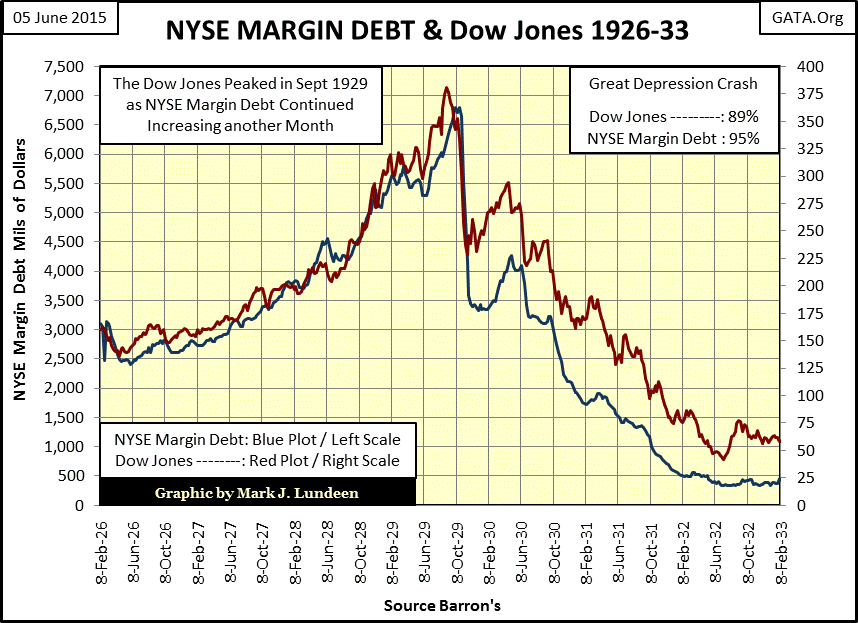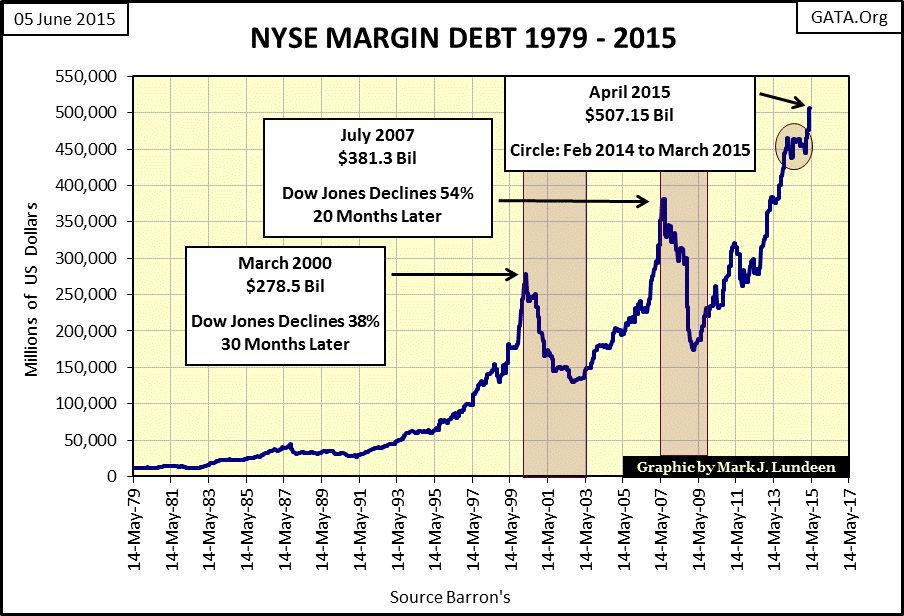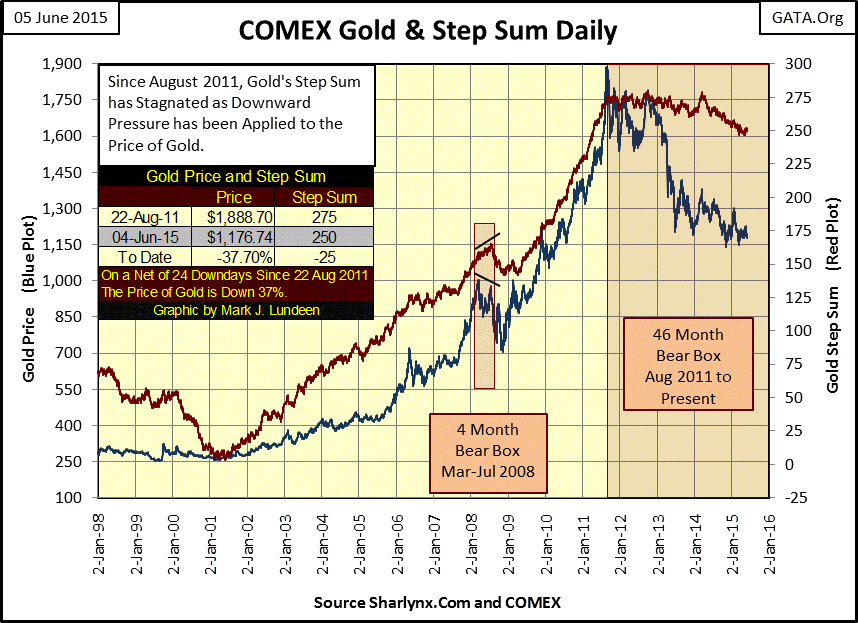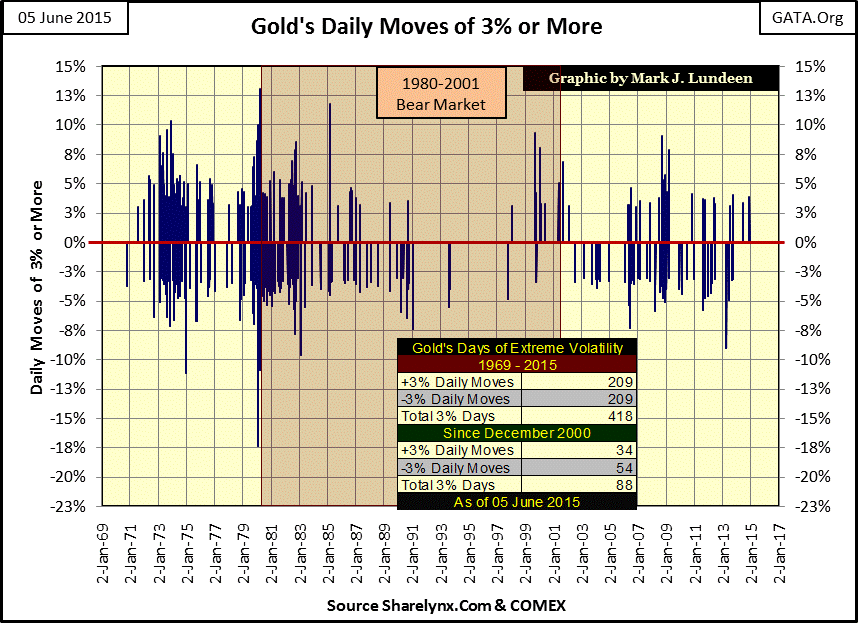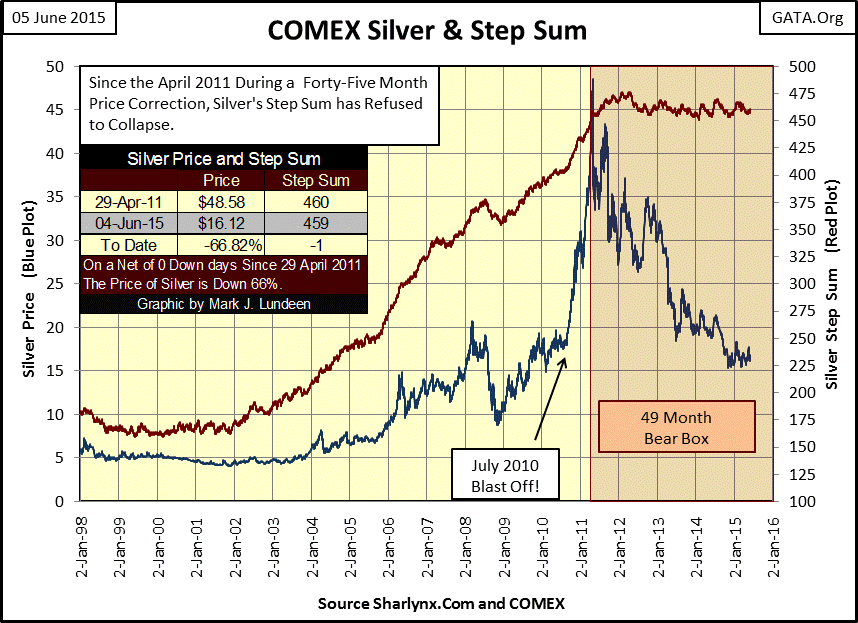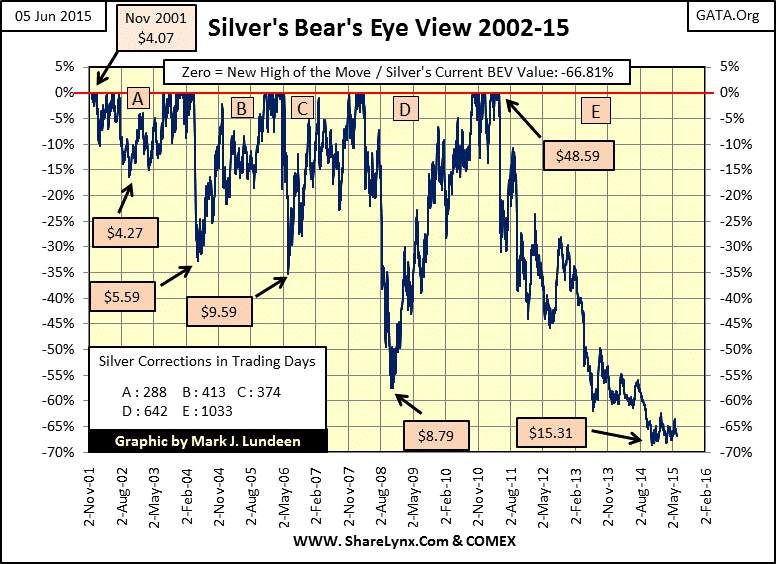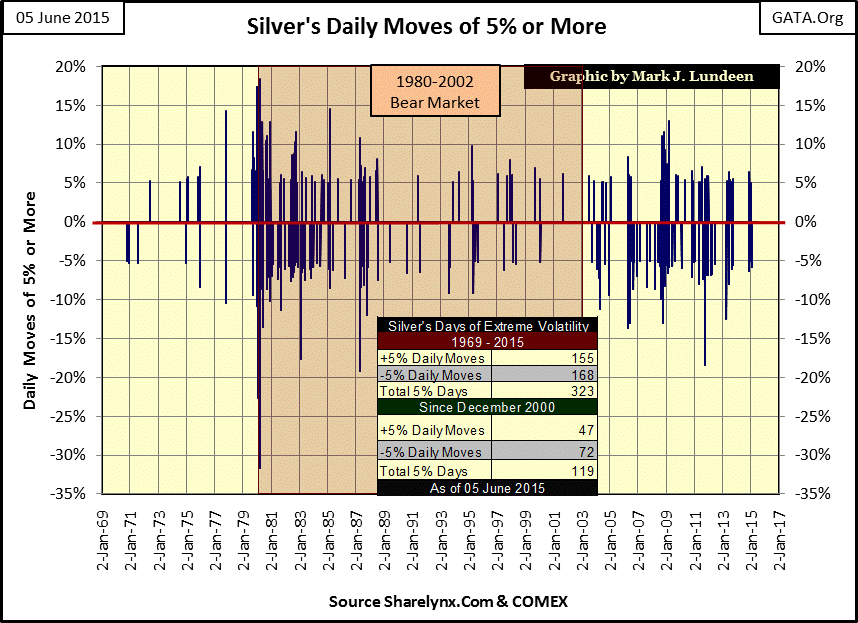Fear And Loathing In The Precious Metals Markets
I’ve come to a point in my market observations where I have little desire to follow current market trends, except for maintaining my data files. I do admit though that I’m closely following Treasury yield daily closings. I expect the next big market move that makes front page news and will originate in the fixed income markets. Up until recently the “policy makers” have had the global bond markets dancing to their tune. However they’ve been playing the same music since the 2008 credit crisis: lower yields, higher financial asset prices with fear and loathing in the precious metals markets. I’m getting tired of listening to this same old song, but then the hardcore alcoholics in corporate America will continue dancing just as long as the Federal Reserve keeps passing out the free booze.
Here’s a quote and chart from David Stockman’s article of June 04: “C-Suite Gamblers—–The Real ‘Dumb Money’ Inflating The Bubble”
“U.S. companies announced $141 billion of new stock buyback programs last month and $243 billion of new M&A deals. Both figures are all-time records, and according to bubblevision are further evidence that CEOs are bullish on their companies and the economic outlook.”
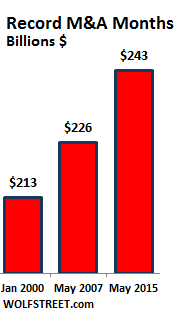
If in 2015 the Federal Reserve can no longer fund quarter million dollar 30-yr mortgages to the unemployed as a means to “inject liquidity” into the economy, they can always count on corporate management to burden their companies with long-term debt in order to buy back shares for a short-term sugar high in share prices. And the best way to understand these M&A deals is to picture corporate management as the abusive beadle in a Dickens’ novel orphanage, with the shareholders (the actual owners of the company) the defenseless orphans.
Without a pliant Federal Reserve inflating the credit markets for the benefit of Wall Street, no one in their right mind would have given “high finance” $243 billion dollars in May to reshuffle the management of corporate America. In fact, these buybacks and M&As are burdening corporate American with unpayable debt that will eventually devastate these companies when Mr Bear returns to claim his pound of flesh from these miscreants.
People today think too lightly about these vast sums now circulating around Wall Street. Back in the early 1950s the Marshall Plan granted Germany and Japan just one billion dollars to rebuild their bombed-out economies. What results do the idiot savants at the Federal Reserve expect for these hundreds of billion dollars flowing into share buyback programs and M&A activities in just the past month?
I’ll tell you my expectations; the Dow Jones (Red Plot below) declined 89% during the Great Depression crash thanks to the credit driven expansion during the Roaring 1920’s (NYSE Margin Debt / Blue Plot) by the then new Federal Reserve. However, from 1926 to 1929 inflation from the Federal Reserve mostly flowed into share prices pumped up by NYSE margin debt, and that’s still true today. However since 2009, management has also been mainlining “liquidity” (debt) directly into their balance sheets for no good economic purpose as Mr. Stockman points out above, and that is one huge difference from the Roaring 20s!
NYSE margin debt reached a new all-time high in April and I’m not at all surprised, but the curious thing about the recent peak is that from February 2014 to March 2015 margin debt was range bound around $450 billion dollars. What could have caused that? Who knows, but looking at margin debt going all the way back to 1926 I’ve never seen that happen before. But just as with corporate buy-backs and M&A activity, margin debt is simply another aspect of credit creation by the Federal Reserve in their vain attempt to keep the financial markets afloat, and for the time being, the academics dictating “monetary policy” are having it their way: lower yields, higher financial asset prices and fear and loathing in the precious metals markets.
Well, you buy them shoes and send them to school and this is what they do to you. Mr Bear must be licking his chops in anticipation of an even greater market collapse than in the early 1930s when our terrible day of reckoning finally arrives. Let’s take the bull by the tail and look at the situation square in the face; any society that allows credentialed morons with no actual business experience to manage the economy and the “means of production” deserves what it gets.
After the four year correction in gold and silver prices I have more loathing for the Federal Reserve than fear of purchasing the old monetary metals at current prices. So let’s take a look at gold and silver’s step sum charts from 1998 to present. Gold’s step sum plot (Red Plot below) shows us the market sentiment of the only people who really matter in a market: those who show up every day to buy and sell. As we see below market sentiment from 2001 to 2011 was bullish. Then came gold’s last all-time high in August 2011 from which gold has corrected 37%. But market sentiment (as seen in the step sum) has stubbornly refused to become bearish, creating a forty-six month bear box.
With the step sum declining some 25 trading days since February 2014, the bulls have become a bit discouraged. Still I really don’t want to close out this bear box just yet as the current decline can’t really be described as a collapse in market sentiment, the point in time where the bulls are clearly seen throwing in the towel. If it was, then the step sum’s decline would be as steep as its advance before August 2011. In a typical bear box situation, I’d expect to see gold take one more significant decline of sufficient magnitude to force the bulls to capitulate, resulting in a collapse of the step sum before I’d turn bullish again.
Will gold’s step sum ultimately collapse, terminating this massive bear box? Heck, last month alone the Federal Reserve created $384 billion dollars for share buybacks and M&A, and they’re ready to do the same again in June and July. In a sane world the price of gold would already be far above its last all-time high of $1,888, taking the step sum with it. Until the world comes to its senses and develops a little fear and loathing for the tsunami of “liquidity” flooding from the global central banking system, I expect technical analysis in the gold and silver market will continue to be problematic. I’m just waiting for the day when we see both plots in the chart above take off like a bat from hell, hot on the heels of rising bond yields and collapsing financial asset valuations. Until then, I plan to wait patiently.
Here we see gold’s Bear’s Eye View (BEV) from its bear market low price ($253) of July 1999. Looking at gold’s price chart above and BEV chart below, it’s obvious it had a nice, if not a rampaging bull market from 2001 to 2011. Gold didn’t see a 30% correction until after its last all-time high of August 2011. For your information the 1969-80 gold bull market saw a 47% correction in August 1976.
Since August 2011, gold has twice attempted to bottom. Will the “policy makers” try to make it bottom a third time? I’m sure they’d like to try, but so far there have been only two attempts to breach the BEV -40% line and the bears have failed both times. In this crazy market it’s foolish to attempt predictions of price and time, so I’m content just to observe the daily price action with no expectations. But it wouldn’t surprise me at all if the bottom is already in place.
But when will gold once again resume the bull market advance that was halted in August 2011? I won’t put a date on it, but when gold once again sees days of extreme volatility (daily moves of 3% or greater up or down), things will change for the better for the gold bulls. 3% moves in the price of gold are rare market events. Since January 1969 there have 11,665 trading sessions in the gold market, of which only 418 have seen gold move 3% or more from a previous day’s closing price. 2% moves in the Dow Jones are almost exclusively bear market events, but that’s not the same with gold’s 3% days which can form clusters during both bull and bear markets, especially during the ten year period from 1973 through 1983.
We should note the change in volatility in the gold market post 1983 as it signifies an important change in the market. What would that change be? I expect history will record that around 1983 the big banks and government began to realize the necessity of controlling the old monetary metals market prices to support their addiction to cheap money and credit. If I’m correct (trust me – I am) a day is coming when gold will smash through its current single day record advance of +13% (19 March 1980) and we’ll once again see a proper cluster of 3% days forming in the chart above as the gold price plot rises far above its last all-time high of $1,888 set in August 2011.
Let’s move on to silver and its amazing step sum. From 2002 to 2011, silver advanced 1100%, compared to gold’s 640%, although the gains in the price of silver just kept pace with gold’s up until the July 2010 blast off. But since April 2011 silver has seen a 67% decline. In any other market, recovering from a 67% decline would take years, but note the current price of silver in the chart below – yep, right where it was when the July 2010 blast off occurred. So we shouldn’t rule out the possibility that even though we are at the bottom of a 67% decline, the price of silver may recover all of its losses of the past four years, and then some within the first twelve months of its next sustained advance.
That’s not a prediction on my part, just an observation that silver went from $15 to $48 in the ten months from July 2010 to April 2011 more quickly and with less effort than it took to decline from $48 to its bottom of $15.31 between April 2011 and November 2014. Silver is a market that wants to go up, and as soon as the heavy hand of “policy” is lifted from it, it will! Just look at silver’s step sum. As of Thursday it has declined by only one net down day after four years of continual market hell for the bulls.
Silver’s BEV chart is an interesting study of its bull market beginning in 2001. I’ve labeled silver’s five corrections over the past fourteen years, A through E. These corrections appear horrible, and they are, with each one suffering a deeper percentage decline than the last. But here’s an interesting fact: even at the November 2014 bottom price of $15.31 silver has still advanced by 267% since November 2001. During the same time period the Dow Jones, which made a new all-time high on May 19th (twelve trading days ago), has only gained 87.5%. The S&P 500 is only up 86% since November 2001.
This is a comforting thought, unless you purchased silver sometime between 2010 and April 2011, which I fear some people did on my recommendation. Sorry, I do the best I can but I’m not perfect. There was no way anyone could have predicted a massive 67% correction in the price of silver lasting 1033 days. But I suspect we are now much closer to the end of the correction than the beginning.
Like gold, I expect we’ll soon see the return of days of extreme volatility marking an end of the current difficulties in the silver market.
The silver market has always been different than gold. Unlike gold, silver saw few days of extreme volatility from 1969 to its January 1980 bull market peak. It’s easy to see exactly when the COMEX changed its regulations to prohibit buying futures contracts in early 1980; silver saw a huge one day decline of 32% which followed a 22% decline the day before. What made the COMEX prohibit the purchase of silver contracts in early 1980? This was unprecedented. The Hunt Brothers of Texas, upset that “a billion dollars didn’t buy what it used to” almost cornered the silver market as an inflation hedge. Unfortunately for the Hunt Brothers, the big NY banks were short silver in the futures markets, so the COMEX took the Hunts out to “save the banks”, although it wasn’t reported as such at the time. But that was then, and this is now. Currently the UK / US banking cartel doesn’t have the same clout they once had because long ago, back in the 1970’s they were the only game in town. Currently, Asia is the rising power in the physical gold and silver market. To tell you the truth, Asia probably likes the idea of JP Morgan and Goldman Sachs finally getting some of what they have been passing around to others for decades – the shitty end of the stick.
Here’s a quote from Mr. Luo of the China Banking Regulatory Commission, expressing his opinion of the Federal Reserve and US Treasury effort to bailout the US Banking system with monetary inflation in the wake of the mortgage debacle.
“We hate you guys. Once you start issuing $1 trillion-$2 trillion [$1,000bn-$2,000bn] . . .we know the dollar is going to depreciate, so we hate you guys but there is nothing much we can do.”
- Luo Ping, a director-general at the China Banking Regulatory Commission, 11 February 2009
I suspect Mr. Luo and others of the Chinese banking system have found a solution to their ever depreciating dollar reserves; they are using their dollars to purchase thousands of tons of gold bullion. And the CFTC and COMEX won’t be able to muscle the China’s central bank as they did the Hunt Brothers. All things considered the future prospects for gold and silver appear brilliant to stellar.






